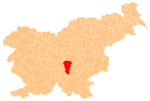Višnja Gora
Višnja Gora | |
|---|---|
Town | |
From top, left to right: Višnja Gora from afar, St. Giles's Church, Valvasor Fountain, House of Carniolan Bee, Educational Institution | |
 | |
| Coordinates: 45°57′28.66″N 14°44′32.03″E / 45.9579611°N 14.7422306°E | |
| Country | |
| Traditional region | Lower Carniola |
| Statistical region | Central Slovenia |
| Municipality | Ivančna Gorica |
| Town | 9 June 1478 |
| Population (2002) | |
| • Total | 813 |
| Post code | SI-1294 |
| Area code | 01 |
| Website | Official website |
| Source: Statistical Office of the Republic of Slovenia, census of 2002. | |
Višnja Gora (pronounced [ˈʋiːʃnja ˈɡɔːɾa] ; German: Weixelburg,[1] also Weichselburg, Weichselberg) is a town in the Municipality of Ivančna Gorica in central Slovenia. It is one of the best-preserved medieval towns in Slovenia. The area is part of the historical region of Lower Carniola. The municipality is now included in the Central Slovenia Statistical Region.[2] It includes the hamlets of Žabjek, Na Štacjonu, and Grintavec,[3] as well as the former hamlet of Suhi Malen (German: Weixelbach).[1][4]
Geography
[edit]The town is located in the Višnjica Valley 20 kilometers (12 mi) southeast of Ljubljana just south of the A2 Slovenian motorway. Nearby is the Kosca Valley with the highest waterfall on a travertine foundation in Slovenia. Regular long-distance bus and rail lines connect Višnja Gora to Ivančna Gorica and Ljubljana.
History
[edit]Višnja Gora was granted town rights in 1478. In the same period, a coat of arms showing a masonry wall with doors and two roofed towers was adopted. The snail representing a local legend was added later. The citizens of the town were given a golden snail shell for nursing the Venetian doge's son wounded in the Battle of Sisak (1593) by his relatives. The golden shell has since been lost, but the legend remains. During the Second World War, Višnja Gora was bombarded by German forces on 22 September 1943. At the end of October 1943, Partisan forces burned Turn Castle, the courthouse, and the school in the town.[3]
| Year | Pop. | ±% |
|---|---|---|
| 1948 | 406 | — |
| 1953 | 537 | +32.3% |
| 1961 | 624 | +16.2% |
| 1971 | 560 | −10.3% |
| 1981 | 655 | +17.0% |
| 1991 | 754 | +15.1% |
| 2002 | 813 | +7.8% |
| 2011 | 1,000 | +23.0% |
| 2021 | 1,135 | +13.5% |
| Population size may be affected by changes in administrative divisions. | ||
Castles
[edit]
The old centre is built on a hill (384 m) under the ruins of Višnja Gora Castle (Slovene: Višnjegorski grad), generally known as Old Castle (Slovene: Stari grad),[3][5] once home of the Višnja Gora knights. A second castle, Turn Castle (German: Weixelbach),[1][3] stood west of the town center. It was also later known as the Codelli Manor (Slovene: Codellijeva graščina) and was burned by the Partisans in October 1943.[3]
Recreation
[edit]The 12 km Jurčič Trail is named after Josip Jurčič, author of the first Slovene novel, Deseti brat, who attended primary school in Višnja Gora. Part of the trail has been recently turned into a forest trail known as Po poteh višnjanskega polža (The Višnja Gora Snail Trail).
Notable people
[edit]Notable people that were born or lived in Višnja Gora include:
- Josip Jurčič (1844–1881), author
- Ive Krevs (1912–1990), Yugoslav Olympic athlete
- Pashkal Skerbinz (1780–1824), religious writer[6]
Gallery
[edit]-
Town hall
References
[edit]- ^ a b c Leksikon občin kraljestev in dežel zastopanih v državnem zboru, vol. 6: Kranjsko. 1906. Vienna: C. Kr. Dvorna in Državna Tiskarna, pp. 96, 99.
- ^ Ivančna Gorica municipal site
- ^ a b c d e Savnik, Roman, ed. 1971. Krajevni leksikon Slovenije, vol. 2. Ljubljana: Državna založba Slovenije, pp. 160–161.
- ^ Skubic, Valentin. 2003. "Moji spomini na osnovno šolanje v Višnji Gori." Klasje 9(4) (April): 7. (in Slovene)
- ^ "EŠD 9674". Registry of Immovable Cultural Heritage (in Slovenian). Ministry of Culture of the Republic of Slovenia. Retrieved 21 July 2011.
- ^ Golia, Modest. "Skerbinc, Pashal (1780–1824)". Slovenski biografski leksikon. Ljubljana: Slovenska akademija znanosti in umetnosti. Retrieved 24 January 2020.








